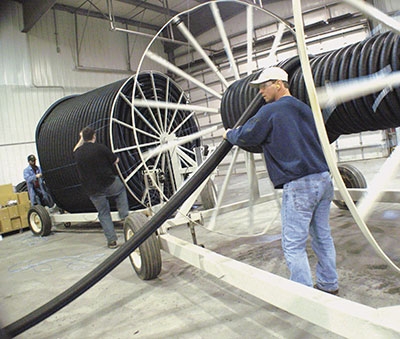
Features
Contractor at Work
Pipe primer
A behind-the-scenes look at how drainage tile is made.
May 8, 2013 By Stefanie Croley
 Four-inch pipe is coiled up into a maxi before it enters the yard for delivery. As a drainage or land improvement contractor
Four-inch pipe is coiled up into a maxi before it enters the yard for delivery. As a drainage or land improvement contractorAs a drainage or land improvement contractor, you know the general ins and outs of installing pipe. But did you ever wonder what it takes to make the giant coils of tile you receive? It’s not often you get a behind-the-scenes look at how pipe is made, from start to finish. Drainage Contractor took a tour of ADS Pipe’s Heidelberg, Ont., plant, to get a hands-on look at what it takes to turn raw materials into coils of drainage pipe.
The three lines of the Heidelberg plant mainly run agricultural and commercial pipe. High-density polyethylene material is set at a let-down ratio to ensure the formula meets quality standards.
“Based on specifications, we look to meet standard ASTMF405 for our four- to eight-inch single-wall pipe,” says Nathaniel Johnston, quality manager. “Ten-, 12- and 15-inch pipe meet the ASTMF2648 standard.”
Each provincial or state association also has its own set of quality specifications, and pipe is made to meet the necessary regulations. Once the material is mixed to the desired standard, it enters the extruder where it flows through the machine and is melted down. From there, it enters a diehead, where it begins to be formed. The pipe continues to flow through into a corrugator, the piece of equipment that holds a clamshell mold to complete the pipe’s formation. “That machine comes in various sizes and molds, and the mold can be changed to fit whatever size is needed, depending on what the customer has ordered,” explains Brad Billings, plant manager.
After it exits the corrugator, the pipe goes through a cooling process (water is used at ADS, but air cooling is also common at other manufacturers). Depending on the customer’s order, a perforation process is next. Water is wicked off and the pipe is perforated at the customer’s request. “If someone calls and says they want solid pipe, we would skip that piece of machinery,” explains Johnston. There are different perforators for different applications: fine slots for sandy applications, muck, for swampy areas, or regular perforation for standard applications. “Different markets require different perforations, and certain perforations are accepted more in different regions,” explains Jamie Turvey, Ontario agricultural sales representative at ADS.
After the perforator, the pipe continues down the line through a puller to keep it moving, before it enters the packaging stage. If necessary, the pipe will go through a sock machine. “If a farmer found his land was sandy in a test hole, he’ll order a sock so the sand doesn’t get into the pipe,” explains Billings. In the packaging stage, if there are any flaws noticed in the pipe, the linesman will cut out the imperfection and fit it with a coupler. At this point, the pipe is packaged into large maxi-coils or smaller sizes at customer preference, and transferred to the yard to fulfill the customer’s order.
The process itself is straightforward, but lots of time is spent on the line on quality control, ensuring pipe is manufactured to meet certain standards. “Even the raw materials are tested to make sure the specification sheet provided by the vendor matches up with the plant’s testing,” Johnston says. At ADS, samples are taken every hour and are recorded in a database and on a sample board. Measurements of each aspect of the pipe are taken, and pipe is subjected to several tests to ensure its durability, including a TUP or impact test to ensure the pipe doesn’t break or crack when it’s subjected to pressure, and a freezer test to ensure the pipe can stand freezing temperatures. Random samples are also sent to ADS’s quality lab in Ohio to ensure the information in the local plant’s database correlates with the lab’s test results.
“Some of this pipe made today might not be used until July,” says Turvey. “There’s a database that tells us what we produced, when and where it was produced, for future reference if needed.”
By the time the tile reaches the customer to fulfill its purpose, the drainage pipe has – quite literally – been put through the ringer to make sure it’s fit for the job.
Print this page